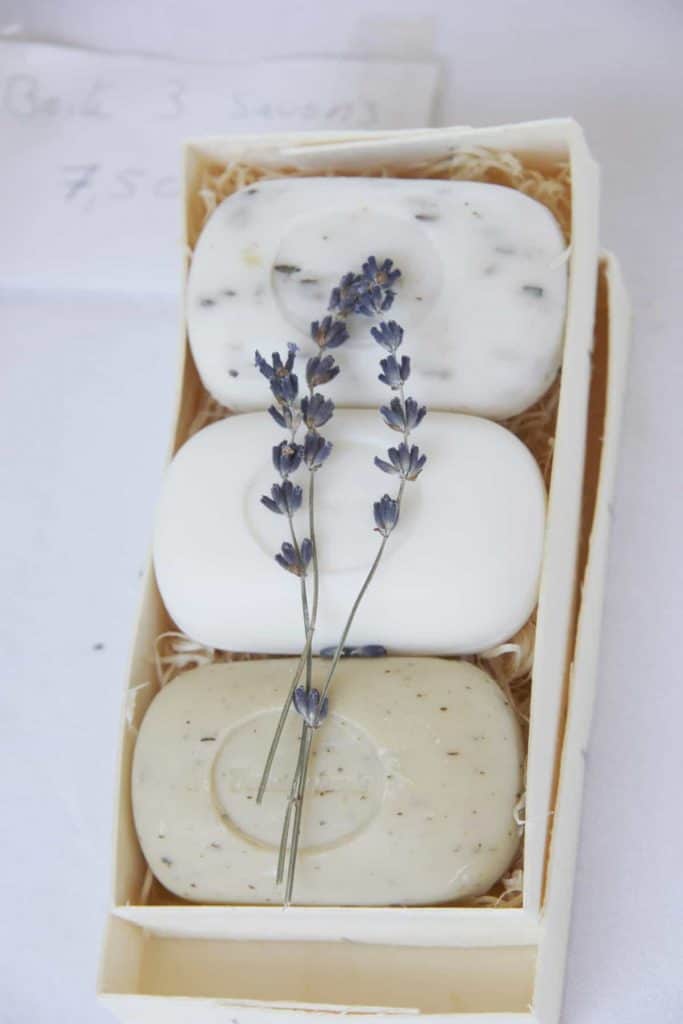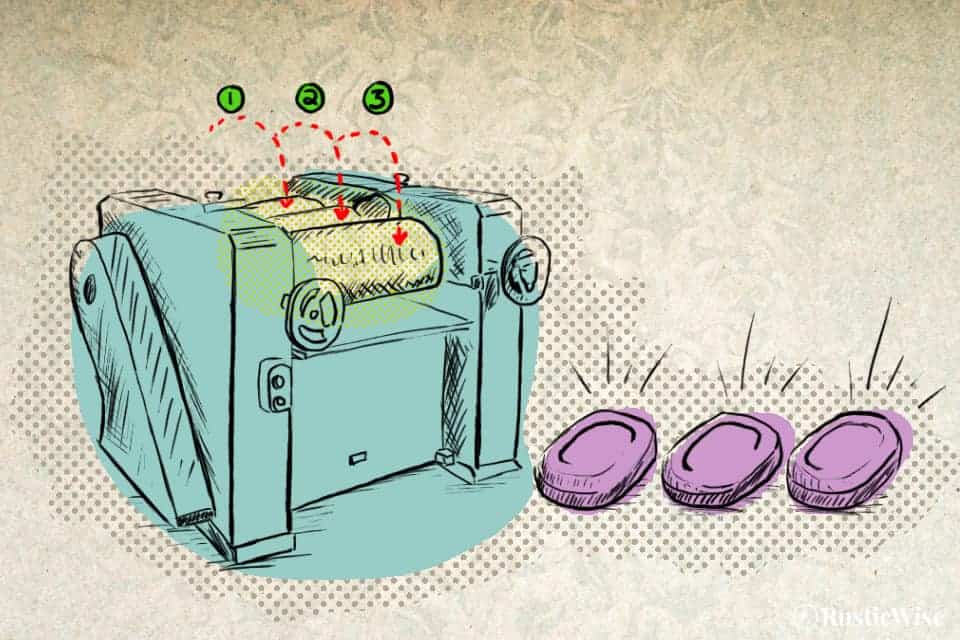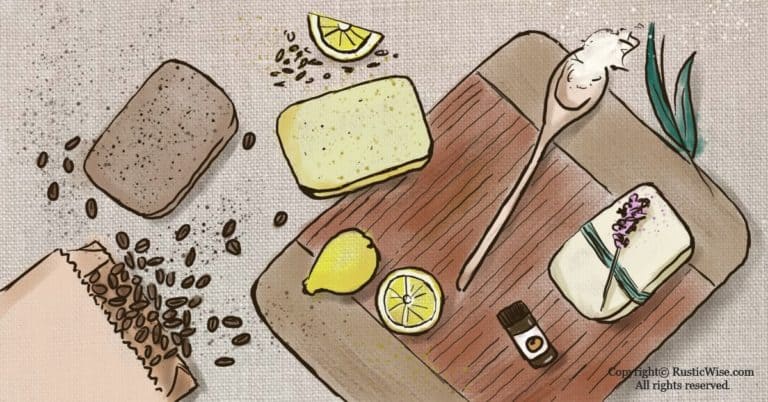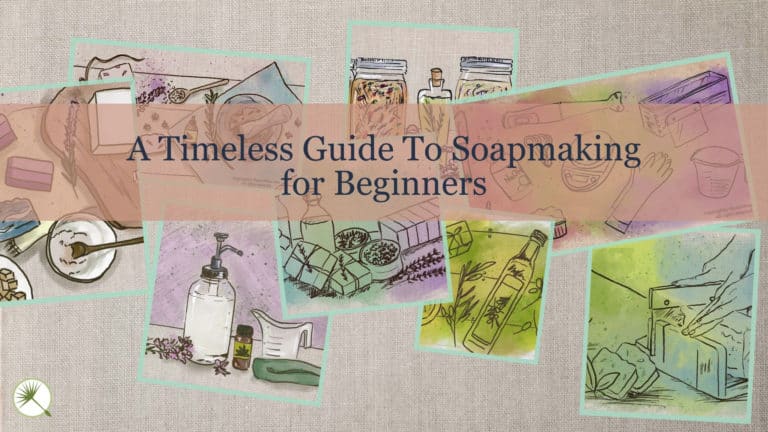What Is Triple Milled Soap and Is It Worth the Hype?
If you’re looking for a way to add a touch of luxury to your everyday beauty and cleansing routine, you may have heard rave reviews of triple milled soap.
So what is triple milled soap, exactly? What differentiates this soap bar from a regular, mass-produced soap bar is mainly the milling process. Triple milled soap is a type of bar soap that has passed through stainless steel rollers at least three times. This helps to remove excess air, create a finer texture, and make the bar soap last longer.
Most manufacturers of milled soap market their products as a luxury product with quality ingredients. Because of this unique finishing process (and related marketing efforts), these soap bars can fetch a handsome price—often double or triple the cost of a regular bar of soap!
Let’s take a closer look at this soap and whether it’s worth the extra money (and hype).
What is triple milled soap and how is it different from regular commercial soaps?
The terms French milled soap and triple milled soap have become synonymous with one another. This is because artisan soap makers from France popularized this unique soap finishing process in the 1700s and 1800s.
All true soaps are produced by combing a strong alkali (typically sodium hydroxide lye), with fats, oils, or butters to create soap. The U.S. Food and Drug Administration (FDA) defines soaps as mainly comprised of “alkali salts of fatty acids.”¹
So, if you see the word “soap” on a product, they must make it through the process of saponification (the combination of fats + oils with lye to produce soap + glycerin).
Many commercial “soap” bars are not truly soaps at all, but synthetic detergents derived from petroleum-based ingredients.
That’s why you’ll see many so-called soaps with names such as “beauty bar” or “cleansing lotion bar” rather than simply “soap.”
The takeaway: Most mass-produced “soap bars” on the market aren’t truly soaps by definition, but actually synthetic detergents, sometimes called syndet bars. A French milled soap bar is made from traditional soap making methods if it has the word “soap” on the label.

A brief history of soap making
While rudimentary bar soap has been produced since ancient times (from animal fats and a slurry of ashes), things really started heating up in the soap making world in Europe in the late 1700s.
In 1790, Nicolas Leblanc discovered how to make soda ash (a strong alkali) from brine.² (You may know that lye, a potent alkali, is a key ingredient of traditional soap making.)²
From there, a French chemist named Michel Eugène Chevreul illustrates that the saponification process (simply the act of making soap) involves splitting fats into the alkali salt of fatty acids (which is soap by definition); the byproduct is glycerin.²
At this point, soap was produced in large vats or pans. Oils and fats were boiled and then combined with lye.
How is triple milled soap made?
Soap makers select various vegetable oils and butters based on the unique properties it lends to the finished soap.
For example, olive oil is known for its gentle, nourishing qualities, which is great for sensitive skin. Coconut oil is high on cleansing power and creates large bubbles.
Manufacturers combine oils, fats, and butters with lye. They then customize each recipe by adding fragrance, color, or additives. Once this mixture has fully saponified (or converted into soap), they pass this mixture through heavy-duty machinery.
The machinery comprises large stainless steel rollers and mesh screens. The mixture passes through the machine at least three times.
This triple milling process is a bit of an art form. Passing the mixture through the machinery too many times results in dry, subpar soap paste.
The pressing of the soap mixture in rollers does several key things:
- Creates a uniform color, texture, and consistency.
- Removes excess water, which can cause soap to melt away quickly.
- Removes any impurities.
Once the soap mixture has passed through the machinery, it’s pressed or extruded into molds to form the desired shapes.

Credit: Vector State
Benefits of triple milled soap
With its hefty price tag, let’s look at the following benefits of French milled soap, according to manufacturers of luxury personal care products:
- More soap per ounce: When you pick up a bar of milled soap, it often feels heavier than your average bar. That’s because, through the finishing process, the paste becomes denser and more compact.
- Longer-lasting: It’s true that these denser soaps last longer than a regular soap bar. How much longer is the issue. It really comes down to how often you use it, and what type of water you have (hard vs. soft water).
- Smooth and consistent texture: After getting squeezed several times through steel rollers, any mixture is bound to be smoother with fewer impurities.
- Creamy: While many manufacturers of French milled soap boast about their soap’s creamier lather, I feel this issue of creaminess really depends on the type of oils or butters used in the soap recipe.
The takeaway: Longer-lasting and with a smooth and consistent texture, there are definitely some real benefits of this fancy soap. However, the creaminess of soap comes down to the types of vegetable oils, fats, or butters used. You can find creamy lather in a bar of handmade soap as well.
Things to look for in a triple milled soap bar
Not all French milled soap or triple milled soaps are created equal. If you’re going to shell out big bucks for luxury soap, do a bit of research first to ensure you’re truly getting quality soap.
Tip: If you have sensitive skin, avoid soaps containing artificial fragrances, or synthetic colorants which can irritate skin.
- Natural ingredients: One of the first ingredients listed on the label should be a natural-sounding name, such as coconut oil, shea butter, or palm oil, to name a few. Sometimes you’ll see olive oil listed as saponified olive oil, or sodium olivate which simply means the sodium salt of olive oil.
- Free of other chemical additives: Sulfates (which include sodium lauryl sulfate and sodium laureth sulfate—better known as SLS and SLES), parabens, and phthalates are all things your skin doesn’t need to stay clean. Scan the ingredients label for names of these chemicals you’re better off avoiding.
- Plant-based: If you’re vegan, or just prefer to stick with plant-based products, check to see if the manufacturer uses animal fats, or petroleum-based ingredients.
Can you make triple milled soap at home?
By the nature of the manufacturing process involved (heavy industrial steel rollers), it’s not possible for the average hobbyist to make triple milled soap at home.
This heavy machinery isn’t cheap, and it takes a lot of space! Most milled soap bars are produced by larger companies in a factory.
What’s the difference between triple milled soap and hand milled soap?
The terms triple milled and hand milled have very different meanings.
You already know that triple milled products are run through heavy steel rollers at least three times to produce a smooth soap.
Hand milled soap, as the name implies, is made by hand. Sometimes this is called rebatched soap. This type of soap is produced by grating a bar of soap into small pieces, reheating the soap to melt it, and then reforming it into molds.
Unlike triple milled soap with its smooth appearance, hand milled soap is supposed to look rustic and a bit lumpy.
Sometimes home hobbyists try to salvage batches of soap gone awry by “rebatching” them.
Triple milled soap vs. handcrafted soap
Comparing these two types of soaps is a bit like comparing apples to oranges.
In nearly all cases, triple milled soap is mass-produced by larger companies using industrial machinery to refine and produce extruded soap. While some companies pride themselves on using natural and sustainable ingredients and production methods, it’s not always the case.
Handcrafted or homemade soaps on the flip side are typically created by an artisan soap maker using traditional cold process or hot process methods. Soap is mixed by hand and poured into molds to harden and cure.
This curing time of roughly 4 to 6 weeks (or up to several months, depending on the type of soap) is essential to allow excess water to evaporate, and for the soap to harden.
It’s worth noting that homemade soaps that are properly cured will also last a long time.
Most times, homemade soaps are crafted with luxurious body butters, premium or organic oils, and natural botanicals that you likely won’t find in common commercial bar soap.
The verdict
Handcrafted soaps can cost more than a mass-produced bar. And triple milled soap bars, as we mentioned, also cost a pretty penny.
Both handcrafted soaps and French milled soaps can be made with natural ingredients (check the label or chat with the soap maker!).
And, both handmade and triple milled soaps can be long lasting, depending on the ingredients used and the curing time (for handcrafted soaps). (Triple milled soaps last longer than the average commercially produced bar.)
With homemade soaps, you’re supporting a small business.
So, it really comes down to choosing where to use your dollars—by supporting a small business (the artisan soap maker), OR, a larger commercial business (hand milled soap producers).
And if you don’t want to fork out big cash for a product we use daily, but still want high quality soap, why not try to make your own?
New to making soap? 🧼❓
👉We have a fantastic overview on the whole soapmaking process here: read our Timeless Guide To Soapmaking.
If you would like to see our soapmaking posts organized by topic type, see our Soapmaking Collection.
Would you like more timeless tips via email?
Fun tips to help you live an independent, self-sustaining lifestyle. Opt-out at any time.


References
- U.S. Food and Drug Administration (FDA), Frequently Asked Questions on Soap, https://www.fda.gov/cosmetics/cosmetic-products/frequently-asked-questions-soap. Accessed June 2022.
- Britannica, Soap, https://www.britannica.com/science/soap. Accessed June 2022.

Author: Josh Tesolin
Josh is co-founder of RusticWise. When he’s not tinkering in the garden, or fixing something around the house, you can find him working on a vast array of random side projects.









